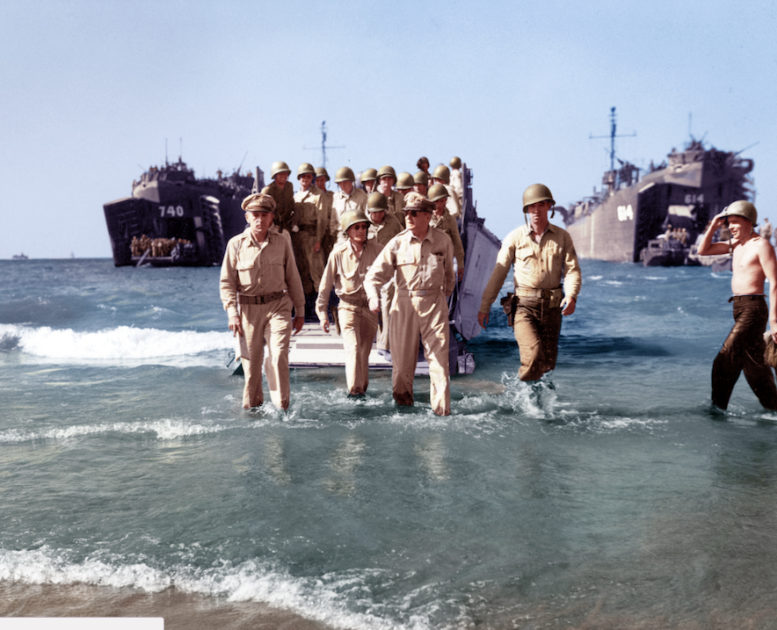Lingayen Gulf, where the famous Hundred Islands National Park lies, is one of the nation’s historical bodies of water. It not only provides a source of livelihood, from fishing to tourism to the coastal cities and municipalities of Pangasinan province but also an ideal venue for naval exercises including amphibious landings. Lingayen town is the provincial capital and lends its name to the gulf. The word “lingayen” literally means “to look back” at an eye catching object which in the olden times was a tall, corpulent tamarind tree at the community center of the “encomienda” later named Lingayen.
Two historical footnotes link with Lingayen Gulf. The first was during the Spanish regime when the notorious Chinese pirate Limahong established his own kingdom in 1574 in the province with his governance center situated at some distance downstream the Agno River. Uncomfortable with the intruder, the Spanish ruler in Manila sent the Spanish Navy, along with hundreds of native troops, to capture and dislodge the pirate in 1575. The Spanish Navy succeeded in its mission to dislodge but failed to capture Limahong, who escaped to China, thereby effectively removing a significant threat to the colony’s physical territory, trade, and commerce in northern Luzon. That specific location at the western part of Lingayen town is now officially marked as “Limahong Channel” and visitors flock the place to see a glimpse of maritime history.
The second was in the WWII when Japan’s 14th Army led by Lieutenant General Masaharu Homma landed in the eastern part of the gulf particularly in the coastlines of La Union’s towns of Agoo, Caba, and Bauang on 22-December-1941. The Japanese then marched towards Bataan and Manila to drive away the American and Filipino defenders and establish control of the country. Three years later, the American liberating forces, with Australian allies, as part of Vice Admiral Jesse Oldendolf’s Task Group 77.2 landed at the gulf’s center beaches in Pangasinan from Sual to San Fabian on 9-January-1945. General Douglas MacArthur joined the troops in Lingayen and Dagupan City a few days later and thereafter led the troops to liberate Manila. Lingayen Gulf became the major military staging point during the liberation with over 200,000 American soldiers setting foot on its beaches. MacArthur had his sentimental journey to Lingayen and Dagupan in 1961.
The years after the war up to early 1990s became a period of environmental abuse. Over-fishing, siltation from savaged watershed, and poor land and water use ravaged the gulf. Fishermen using dynamite and other toxic substances destroyed precious corrals and reefs while notorious land dwellers denuded the watershed including mangrove areas. Local government officials and law enforcers failed to institute measures to regulate the use of land and water resulting in environmental degradation that contributed to the pollution of the gulf. These man-made activities in the gulf and in some coastal nations in the region became prevalent, prompting the ASEAN and the USA with the International Center for Living Aquatic Resources Management (ICLARM) as the lead organization to embark on coastal resource management (CRM) project in early 1990s.
The gulf is one of the chosen areas under this CRM Project. The goals of this project are: increase awareness of the importance of CRM policies including the strengthening coastal resource management capabilities; analyze, document and spread out information on trends in CRM; provide technical solutions to resource-use conflicts; and promote institutional arrangements for multi-sectoral planning to improve coastal resource development. In 1992, the NEDA and the Philippine Council for Aquatic and Marine Research and Development formulated the Lingayen Gulf Coastal Area Management Plan. This led to the issuance in 1993 of Proclamation No. 156 declaring Lingayen Gulf as an Environmentally Critical Area (ECA).
To facilitate the implementation of the 1992 Plan, the President created in 1994 a Presidential Commission through Executive Order No. 171. The DENR Secretary chaired the Commission with the secretaries of Agriculture, Interior and Local Government, Tourism, National Defense, NEDA Secretary General, Presidential Management Staff, Governors of Pangasinan and La Union, Regional Development Council Chairperson, and town mayors of municipalities along the gulf as members. Also included are consultants from the private, business, agricultural, and religious sectors and NGOs. In the same year, the President institutionalized the “National Marine Policy” to focus on marine-based industry development.
The Lingayen Gulf Coastal Area Management Commission’s principal task is to formulate a 10-year Master Plan and a 20-year Integrated Master Plan affecting Lingayen Gulf’s preservation, use and sustainability. The local government executives perform the difficult tasks on the ground in respect of Lingayen Gulf as an ECA.
Already, several accomplishments have been noted since the management plan has come out. To highlight the significance of the gulf the provincial government in 1995 constructed a museum in an open space at the back of the capitol building and improved the public beach infrastructure. A concrete pavement known as the “Baywalk” along the beach from Lingayen to neighboring Binmaley town serves both the motorists, beachgoers and health enthusiasts. With the concerted efforts of Governor Amado Espino Jr and Representative Leopoldo Bataoil, the baywalk, started in 2013, will further extend eastward to Dagupan City.
Representative Bataoil complemented infrastructure building and tourism efforts with the planting of ilang-ilang trees in some denuded areas in his congressional district. As Chair of House Committee on Veterans and Affairs and Welfare, Bataoil constantly engages the WWII veterans in Pangasinan who as guerillas helped MacArthur’s landing in Lingayen Gulf. Paying tribute to those freedom fighters during the awarding of WWII Gold Medals mid-November 2018, the Congressman committed to restore the historical value of Lingayen Gulf, and in doing so, increase tourism, and make it sustainable for the future generations.
